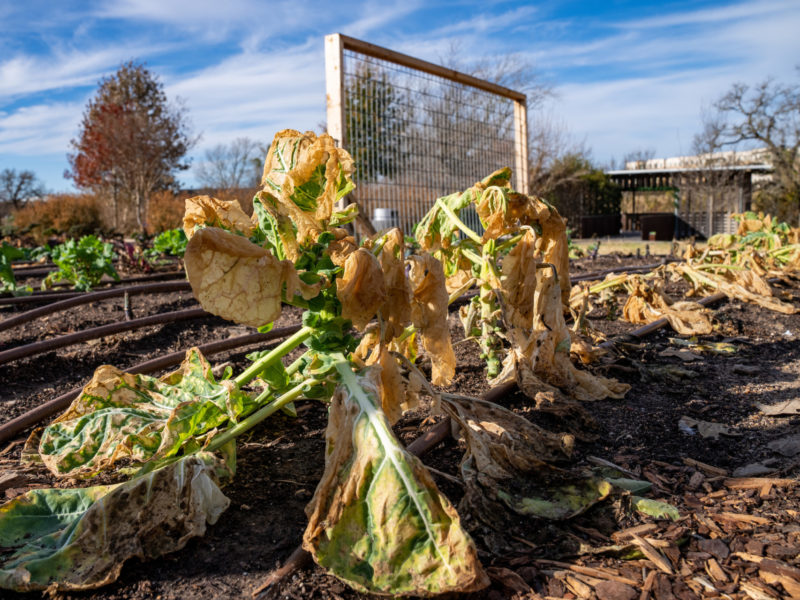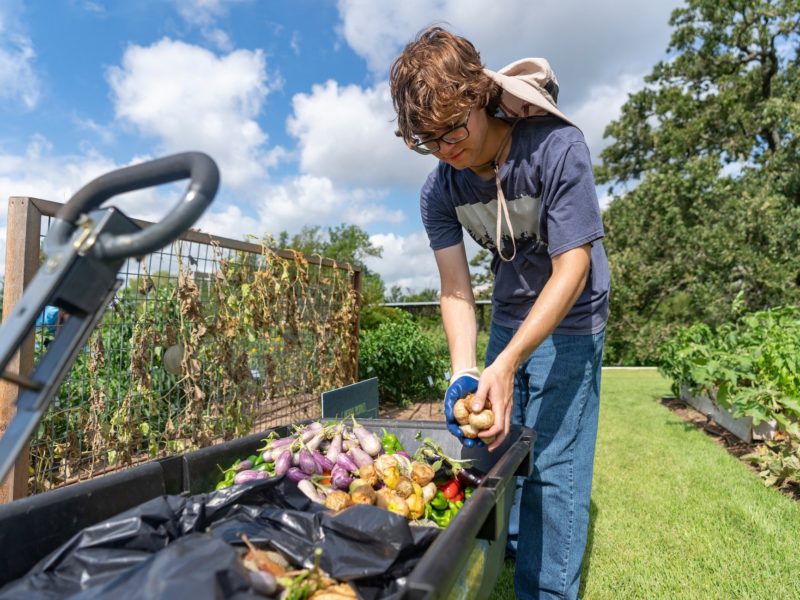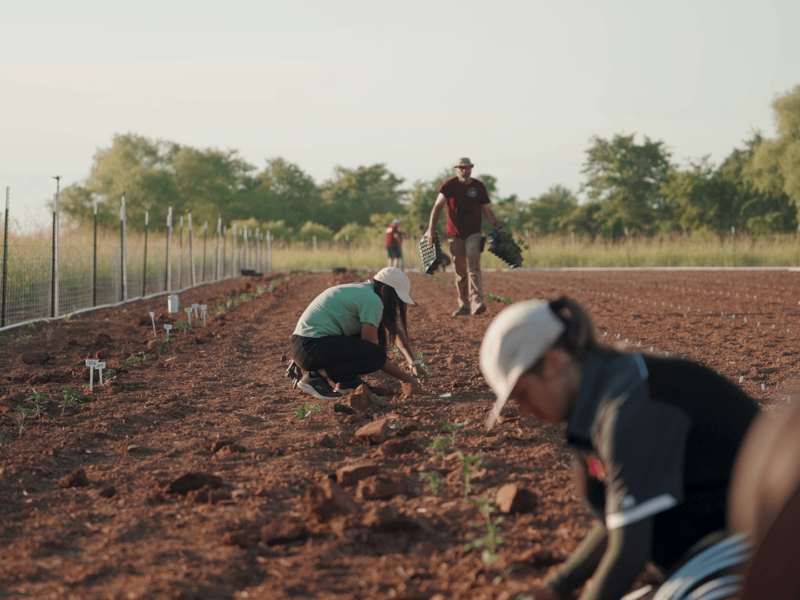Growing A Dream Into Reality

When Joseph Johnson ’88 attended Texas A&M University as an undergraduate majoring in horticulture, the idea of a teaching garden on campus was just a dream for faculty and staff. After his graduation, he launched headfirst into a dynamic career managing public gardens and green spaces, giving him the unique expertise necessary to help make that teaching garden dream a reality.
Eventually, Johnson returned to Aggieland in July 2016 to be the program manager for The Gardens at Texas A&M University, overseeing the construction of the seven-acre Leach Teaching Gardens. He worked closely alongside the design team, consultants and construction contractors while assisting the Texas A&M Foundation with fundraising efforts.
The gardens, named for lead donors Amy ’84 and Tim ’82 Leach, opened on June 15, 2018. To date, tens of thousands of people, from Bryan-College Station residents and Texas A&M students to school field trips and horticulture industry tour groups, have visited and enjoyed informative tours, signature events and volunteer opportunities at the beautiful, serene retreat nestled in the middle of West Campus.
The dream is now a beloved place that brings faculty, students, staff and the community together with Texas A&M AgriLife teaching, research and extension programs.
Connecting People With Nature
Johnson discovered his professional purpose as a horticulturist with the Dallas Arboretum and Botanical Garden, his first job after graduating from Texas A&M with a Bachelor of Science degree in horticulture.
“That job was where I developed my love for public gardens and connecting people with the benefits of being in a natural environment,” Johnson said. “It was a niche that set the course of my career.”
Johnson was a working supervisor performing general landscape maintenance, assisting with educational, volunteer and research projects, and providing technical assistance with garden development projects. He helped design the renovation of the Herb Garden, upgraded the Camp House landscape and maintained the Amelia Lay Hodges Ornamental Garden.
Those skills he gained in horticulture, construction and management became the foundation for the challenging and expanded roles that would come his way.

Healing With Horticulture
In 1990, Johnson returned to his hometown of Houston as the manager of grounds and landscaping at The University of Texas MD Anderson Cancer Center. He met with then-President Dr. Charles LeMaistre, whose vision of MD Anderson as a world-class cancer treatment center included transforming the institutional-looking facilities and paved parking surfaces surrounding the buildings into landscaping and gardens.
Johnson said LeMaistre was interested in the patient recovery research conducted by Dr. Roger Ulrich, who was an architecture professor and director of the Texas A&M Center for Health Systems and Design. Ulrich’s work showed that the design of health care facilities and environments can positively impact health outcomes.
“For example, including a natural environment can reduce stress and benefit patients and caregivers as well as hospital staff,” Johnson said. “Having patients look out their window and see green spaces instead of brick walls, including landscape artwork down hallways with no windows, bringing plants into interior spaces and creating balcony and patio gardens are all ways horticulture can help patients physically and mentally.”
For 20 years, during vigorous capital campaigns and growth, Johnson worked with landscape architects, designers and planners to create and manage more than 50 acres of landscaped gardens and 300 acres of campus and interior public spaces for the center. His expert knowledge of design and horticulture often eliminated the need for costly corrections.
Johnson expanded the rose garden to provide fresh-cut flowers for patients and installed the Chrysalis Project, a butterfly garden featured in Southern Living magazine. He said the rose garden was the catalyst for implementing more organic gardening practices.
“Knowing those roses would be taken into patients who had compromised immune systems, we identified and improved ways to reduce the use of fungicides, lowered the tolerance of having some black spot and powdery mildew on leaf foliage, and still had beautiful roses for the patients,” Johnson said.
Combining gardens and eco-friendly practices created an oasis of care, relaxation and renewal.
“It’s part of healing,” Johnson said. “It was fulfilling to see patients and visitors come to the gardens and get their minds off what they were dealing with. People from all over the world came there and were interested in the plants and gardening. It was a pleasure to talk with them about it.”
Rebuilding And Reviving
In 2010, Johnson was ready for a new challenge. He became director of horticulture at the 252-acre Shangri La Botanical Gardens and Nature Center in Orange, part of the Nelda C. and H.J. Lutcher Stark Foundation.
In 2008, the center was the first project in Texas and the 50th project in the world to earn the U.S. Green Building Council’s Platinum certification for Leadership in Energy and Environmental Design for New Construction. But, that same year, the brackish, salty storm surge from Hurricane Ike flooded the gardens, leaving extensive damage.
When Johnson came on board, he spearheaded the restoration of the gardens, enhancing organic gardening methods and diversifying plant materials across the 20 acres of distinct garden vignettes or themed “rooms.” He upheld the garden’s award-winning ecological energy and environmentally conscious construction practices. This included incorporating materials such as galvanized steel, rough-cut cedar, reclaimed cypress, recycled brick and solar panels for electricity generation into various buildings and structures.
In conjunction with the Shangri La Gardens Education Department and the Stark Foundation, Johnson developed and led numerous garden and nature-related workshops and programs for adults, youth and families.

Building The Dream
While Johnson cherished his role in overseeing the gardens at Shangri La and amplifying its outreach with the public, in 2016 Texas A&M was on the brink of breaking ground on the long-awaited teaching garden, a project desired by many Aggies. With designs and construction documents finalized, the search was on for someone with the background and experience to guide the garden’s construction and maintenance.
Johnson’s expertise was an excellent match for the position, and returning to Texas A&M to contribute to establishing a top-tier teaching garden at his alma mater was both an honor and a dream job. So, he applied.
As the construction fence for the monumental project went up on campus, Johnson joined The Gardens staff and played a pivotal role in overseeing the construction process from inception to completion.
In the same way that he had collaborated with landscape designers, architects and construction crews at MD Anderson and Shangri La, Johnson’s knowledge of horticulture was crucial in anticipating and preventing problems. He is also affiliated with the Texas Nursery and Landscape Association, is a Texas Master Certified Nursery Professional and has Texas Commission on Environmental Quality Irrigator and Texas Department of Agriculture Pesticide Applicator licenses.
“It’s important to have someone on-site to ensure electrical lines do not cross existing tree roots, irrigation lines are installed properly with relation to the foliage, space for plant materials are planned for how big they will eventually grow above and below ground, and always design for maintenance,” Johnson said. “The architect and design teams were knowledgeable and thoughtful about ensuring that these gardens were robustly built and made to be here for many generations to enjoy.
“It was also imperative that, as a teaching garden, the Leach Teaching Gardens would be curated with a plant collection adaptive to the local climate, grown in native soil and irrigated with domestic water – all conditions challenging to sustain a beautiful garden,” he said.
Free and open access was also an essential aspect of the design so that visitors of all ages, demographics and financial capabilities could enjoy the natural setting, Johnson said.

Managing The Gardens
For almost six years, Johnson has diligently nurtured and maintained the campus oasis and teaching laboratory in his role as gardens manager. Each day brings new challenges, and the gardens continually change with the seasons.
Johnson maintains a frenetic pace while directing horticultural and grounds maintenance such as planting, pruning, weeding, mulching, turf maintenance, irrigation and pest management. He helps develop volunteer, student worker and intern opportunities and assists with special events and fundraising efforts. He represents The Gardens with university departments, donors and stakeholders.
His love of providing the best in public gardens and spaces is evident in his ever-present smile and enthusiasm in each role.
“In this sustainable garden space, we bring people and nature together to share with the world the innovation and passion we have for agriculture, the environment and feeding the world,” said Dr. Michael Arnold, director of The Gardens and professor in the College of Agriculture and Life Sciences Department of Horticultural Sciences.
“The depth of Joseph’s experience in developing and managing public gardens was crucial not only to the completion of our beautiful gardens, but is also reflected in his exceptional management of day-to-day operations and the first-rate activities and experiences he provides our visitors, faculty and students. We are incredibly thankful for him and all he does.”
This article by Helen White originally appeared on AgriLife Today.





